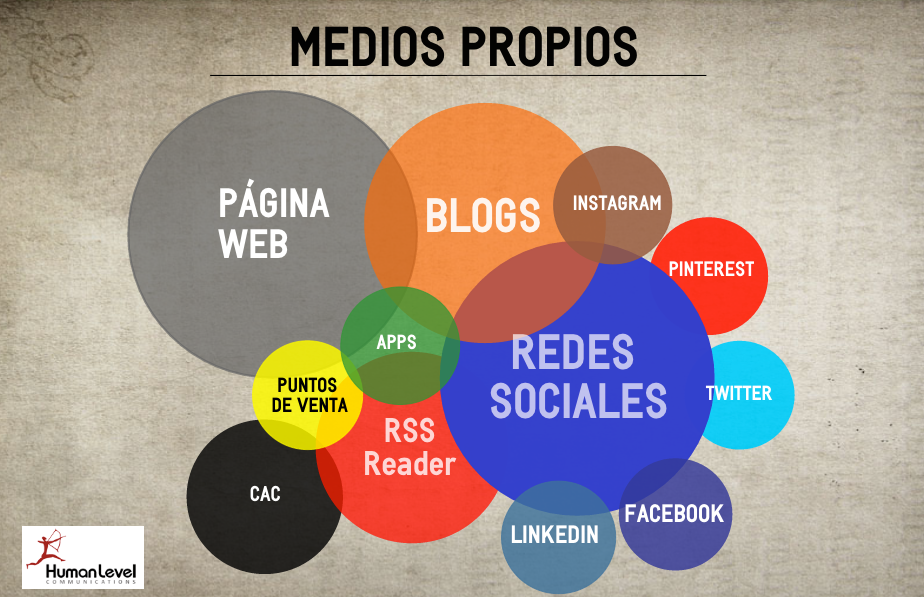Written by Manuel Barrios Carrasco
Index
What is owned media?
In traditional marketing and, by extrapolation, in Online Marketing, we talk about the different media that companies or brands have to develop their online marketing and communication strategy. We talk about Owned Media, Paid Media and Earned Media.
Owned media are those that the brand creates or owns, either totally or partially. These are all those media, platforms or communication channels created by the brand to interact with the customer or user.
Examples of owned media
These include the following:
- Website.
- Mobile website.
- Blog.
- Social Networks: Facebook, Twitter, Instagram, Pinterest, Google+, Linkedin, etc.
- Mobile applications or Apps.
- Ebooks.
- Newsletters.
- Infographics.
- Physical Points of Sale.
- Customer Service Centers or CACs.
Some of them are owned and created by the brand, such as the web, the blog or mobile applications, while others are not fully owned but partially owned, such as social networks, which use an external platform that is not owned by them to create a channel that ends up becoming their own.
Objective of owned media
The purpose of the use of these proprietary resources is to create an environment of communication and interaction with the user, to establish relationships with them in the medium and long term and to be able to influence the customer journey by getting these users to interact with the brand, to become potential customers and even customers and brand recommenders, generating earned media, at no cost, to help achieve the brand’s objectives.
By making these media available to the users, they are the ones who approach, get informed and gain confidence in the brand, being able to fulfill the desired process of transforming the user, who came to the media without investing externally, into a customer.
Own media can be very useful to capture a large volume of public or audience in the early stages of the funnel process of converting users into customers.
Benefits of owned media
Initially they can provide brand awareness, audience for the brand, in those phases of brand and product awareness. These own media can have a positive or negative influence when participating in the communication with the company, to gain or lose confidence in it and at the same time to awaken interest in the products or services of the brand, generate confidence in it and even become customers of it, even becoming prescribers or detractors of it.
These media should be used according to the Online Marketing strategy, in the different phases of the customer journey, always having a clear objective and establishing a means of measuring the achievement of the same.
Sometimes the objective of the own media will be to make the brand known and attract an audience, for example visits to the website or blog, other times to convert that audience into a qualified audience, when we attract people interested in the type of product or company that we are, or we attract people interested in the type of product or company that we are. leads because the user leaves us their email, follows us on social networks or subscribes to our RSS. On different occasions we will use them with the objective of getting that audience to engage with the brand and, for example, comment and share our content on social networks, leave responses on the blog, download the mobile app, download an infographic or PDF, or call for information to the CAC. The most interesting objective will be when we get the user to buy our products through the website, hire services through our site, pay for an application or become a recommender giving us notoriety or referring to us in their social networks, blog or transmitting us their popularity through links recommending our content.
It will be vital to know which of our own media we should trust to use in our online strategy, what investment of time, personnel or economy we should invest in them, and when to use them in the communication and customer relationship process.
Ideally, there should be a convergence of these owned, earned and paid media in the online marketing strategy to achieve the brand’s objectives.
Disadvantages of owned media
Although they are their own and it is understood that they do not generate expenses, it is necessary to allocate resources, both economic and temporal and human, to generate them and to manage them properly. They are not free means, they have a cost, although they should be understood as a necessary investment.
They need time, they are not immediate generators of traffic, conversions or recommendations, they need development and time of good management to show the first results. It is true that the success of the strategies in which we use our own media is scalable over time.
It is essential to have an optimal management to be able to generate trust through them, being the main way of corporate communication, it is necessary to have a correct treatment of them in order not to create a communication or brand reputation problem.
